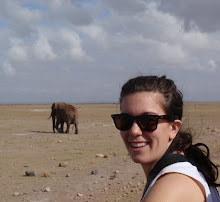We had our first spear-throwing lesson the other day. After a couple throws, I really got the hang of it; between experience from volleyball, basketball, lacrosse, tennis, baseball, and generally just tossing anything around, it wasn't to difficult to get the feel for it. It felt kind of like serve-shooting a really heavy lacrosse stick in fact.
The spear is about six feet long. In the center there is a dark wood handle flanked on one side by a metal point and on the other by a long metal knife. You can throw with either end forward, though if you are really hunting or trying to kill something you would throw with the knife end forward. As I mentioned before, one good throw can pierce an elephant and kill it.
Daniel, our Swahili teacher and a Maasai, was instructing us, and in demonstration hurled his spear about 45 yards with a running start. Needless to say I'm not quite there yet, but I'm confident it will come. I'm thinking that practicing in Dunster courtyard might be good to keep my skills sharp throughout the year.
Anyway, the Maasai are really the most interesting people, from the spear-throwing abilities to their deep, deep knowledge about the land on which they live. Out forty plus tribal groups in Kenya, the Maasai are unique in that they are among the few who have refused to modernize, and largely retained their pastoralist, semi-nomadic lifestyle.
There is a lot about them that remind me of the Greek heroes that I studied this past semester. Even their type of dress for men is based off of the Greco-Roman toga (apparently this is because they immigrated from the Roman-occupied North Africa).
They divide themselves into different age classes: young boys, older boys, warriors (murrans), junior elders, and elders. (This is mostly in reference to the men, as once women marry they become the age set of their husband, regardless of what their age actually is.) The murran stage is one of the most interesting.
To be initiated into the murran stage (at ages of around 17-25), all of the boys come together for a big ceremony in which they are publicly circumcized. If they show any signs of pain during the circumcision, they are outcast by the community, though once the circumcision is over, they are allowed to react however they like.
Following circumcision (which nowadays can be performed in hospitals to ensure cleanliness of the operation), the murrans have about three months to recover, and then move away from their boma (homestead) to a special training camp with other murrans and senior elders. They live there for a few years training and basically form the standing army of the Maasai people. With more Maasai going to schools, they basically attend school like other Kenyans, and then when they are on break they will go join the camp of murrans (if they are in that stage) and continue with life as usual there, until it is time to go back to school.
During this period, they are never allowed to eat alone, or in the presence of women. They braid their hair and paint it with red dye. Currently, we are waiting for the time of circumcisions, so I haven't yet seen any murrans, but the ceremony is supposed to be occurring sometime within the month.
That is about all I've got for now. On Tuesday we leave to camp out at Tsavo National Park for a week, where I will not have internet access, so you will have to just wait for a bit to hear my next news brief. I have a feeling it will be an exciting one as we are not allowed to go to the bathrooms alone at the camp site after dark because of animal attacks, and apparently when you go you just see eyes everywhere looking at you. Students apparently get nightmares pretty commonly--not surprising if there are lions walking in between your tents when you're asleep.
Subscribe to:
Post Comments (Atom)





No comments:
Post a Comment